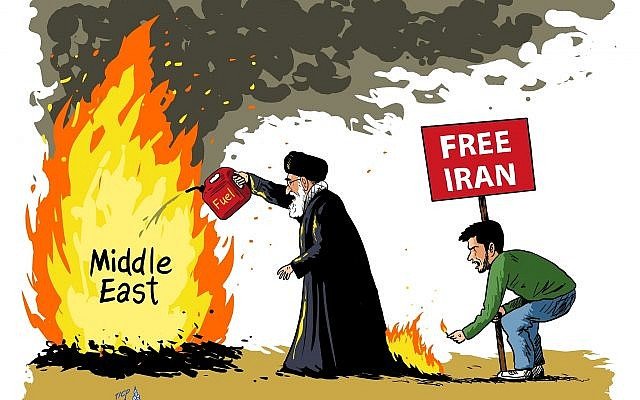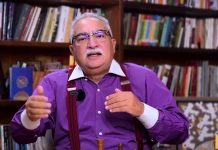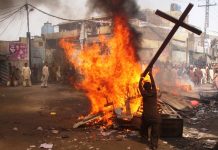إيران وحزام «آية الله» الناسف المزيف
أمير طاهري/الشرق الأوسط/22 تشرين الثاني/2019
Iran and the Ayatollah’s Fake Suicide-Belt
Amir Taheri/Asharq Al Awsat/November 22/2019
Like other totalitarian ideologies, from its murky beginnings in the 1960s, Khomeinism, has tried to encapsulate its raison d’etre in a single word.
The first word, used against the Shah’s reforms including equality for women and land for landless peasants, was “mashru’eh”, supposed to symbolize the primacy of religious law over manmade legislation.
In the early 1970s, the ayatollah adopted another word: “Islam”. He claimed he would not allow “one word more or one wordless.”
By the late 1970s, the magic word had been replaced with “Enqleab” that, in Persian, means “revolution”. Soon, however, the word lost all meaning as an emerging Nomenclature replaced the ousted ruling elites and started behaving worse than the fallen regime.
The magic word for the 1980s was “Jang” (war) which Khomeini said was “a blessing from God” to guide his “10-million-man army” to conquering the Middle East, including “Holy Shrines” in Iraq, and wiping Israel off the map as a starter for “ending America.”
As those dreams faded with the dawn of reality, like fog as the sun rises, another catchword was put into circulation:”muqawimah“(Resistance). But that magic word also proved hollow when the “Imam” drunk his chalice of poison and agreed to end the war with Iraq without having “liberated” either Karbala or Jerusalem.
Khomeini’s successor, Ayatollah Ali Khamenei tried to impose his ideological imprint by expanding the one-word shibboleth into a three-word one: “Tammadun novin Eslami” which means “the new Islamic civilization.”
To promote his slogan, the ayatollah wrote “open letters to the youth of the world”, inviting them to adopt the Khomeinist version of Islam as a template for a new civilization.
He also created a special office headed by the US-trained gynecologist Dr. Ali-Akbar Velayati, complete with a generous budget, to promote the idea.
In that capacity, Velayati went to Cairo in 2012 to advise then Egyptian President Mohammed Morsi to disband the army, create a revolutionary guard, and sign an alliance with Tehran.
At home, the message was that the current “Islamic civilization”, which, of course, had been a product of Iranian “thinkers”, had become ossified, no longer able to raise “pure Muhammadans thirsting for martyrdom.” It was necessary to teach the youth to forgo transient joys of life and strive after martyrdom “the highest peak of human achievement.”
It is now clear that Khamenei’s three-word slogan has failed to make as much as a ripple in the ocean of human reality.
Contrary to his expectations, the youths of the world are not forming queues to secure copies of his epistolary efforts from Islamic embassies, although these are given free.
Inside Iran, cultural production, from poetry to cinema, and passing by architecture and music, are, increasingly, emptied of whatever Islamic content they once had. Rahim-Pour Azghadi, a member of the High Council of Islamic Culture in Tehran laments “the virtual domination of Western culture” in people’s lives in the Islamic Republic.
Thus, when Iranians rose in rebellion last week, using the tripling of the price of petrol as a pretext to vent their anger and frustration, it was clear that Khamenei’s three-word slogan must now join Khomeini’s one-word ones in the graveyard of shibboleths.
Shaken by the popular uprising that, according to the Islamic Ministry of Interior, affected more than 100 cities, Khamenei and his team started looking for a new slogan. On the third day of the weeklong protests, that may or may not continue, albeit, with different rhythm and tempo, they came up with a new slogan: “amniyat” (security).
“Security is our red-line, Khamenei declared in one of his sermons to a captive audience.
“There can be no government, no country without security,” echoed the daily Kayhan that reflects the views of the “Supreme Guide”.
In an editorial, Kayhan spoke of “plundering people’s homes and shops, and burning government offices and killing many innocent citizens.”
For his part, Hojat al-Islam President Hassan Rouhani invited the people to cherish the security they enjoy and not allow it to be undermined by “evil troublemakers.”
To hammer-in the claim that the uprising threatened national security, the regime fomented a sense of insecurity. The state-controlled media run identical reports, concocted by a “star-chamber” of propagandists, about shopping malls and supermarkets being looted, bank branches robbed and set on fire. They also claimed that “foreign agents and killers” had organized and led the protests.
To thicken the broth, the government advised members of the military and security services not to appear in public alone. Members of the Shi’ite clergy were advised to keep a low profile and, whenever possible, avoid wearing traditional clothes in public.
The sense of insecurity the regime wished to foment was boosted when foreign “Jihadists” invited to Tehran for the Islamic Unity Conference, were told they had to leave Iran earlier than scheduled as “pilgrimages” to Mashhad and Khomeini’s “Holy Shrine” were canceled.
However, like all other slogans used by the Khomeinist elite in the past 40 years, the “security” slogan is based on a pack of lies.
This is how the official news agency IRNA on Wednesday 20 November reported what it termed “serious damages to national security”:
1- Robbing chain stores in two cities in the Tehran Province.
3- Breaking the windows of {some} cars.
4- Cutting off the Internet throughout the country
5- Death of a number of citizens involved in disturbances.
It is interesting that even the cutting of the Internet, a government decision, is imputed to protesters.
Does IRNA’s “detailed report” indicate a situation in which “national security is threatened”?
Having failed in everything else, Khamenei is now trying to cast himself as the sole guarantor of security for Iranians, implicitly threatening them with a “Syria-like” tragedy. His apologists abroad, including some remnants of the Obama administration, warn against any action that might provoke Khamenei into activating his “suicide belt”, to blow himself up and with it the entire Middle East.
A Kayhan editorial Wednesday called for “revenge against those who organized the riots”. It demanded to attack their “sensitive strategic and economic centers”, adding “We can easily bring them to their knees,” presumably by activating Khamenei’s suicide-belt.
In this opinion, however, Khamenei’s “suicide-belt” is as fake as everything else in a regime that has lost the confidence of the people.
إيران وحزام «آية الله» الناسف المزيف
أمير طاهري/الشرق الأوسط/22 تشرين الثاني/2019
شأن الآيديولوجيات الاستبدادية الأخرى التي بدأت بشكل غامض في ستينات القرن الماضي، فقد حاولت الخمينية أن تغلف سبب وجودها بكلمة واحدة.
كانت الكلمة الأولى التي استخدمت ضد إصلاحات الشاه، بما في ذلك المساواة للنساء، وكذلك الأرض للفلاحين الذين لا يملكون أرضاً، هي كلمة «المشروعية» التي كان من المفترض أن ترمز إلى سيادة القانون الديني على التشريعات التي صنعها الإنسان.
وفي أوائل السبعينات، تبنى آية الله كلمة أخرى هي «الإسلام» وادعى أنه لن يسمح «بكلمة واحدة أكثر أو كلمة واحدة أقل».
وبحلول أواخر السبعينات، استبدلت بالكلمة السحرية كلمة أخرى هي «انقلاب» وتعني بالفارسية «الثورة». ومع ذلك، سرعان ما فقدت الكلمة معناها حيث استبدل الحكام الجدد النخب الحاكمة المخلوعة وبدأت تتصرف أسوأ من النظام الساقط.
كانت الكلمة السحرية في الثمانينات هي «الحرب» التي قال الخميني إنها «بركة من الله» لتوجيه جيش يتألف من «عشرة ملايين رجل» لغزو الشرق الأوسط، بما في ذلك «الأضرحة المقدسة» في العراق، ومحو إسرائيل من على الخريطة باعتبارها بداية «القضاء على أميركا».
عندما تلاشت تلك الأحلام مع فجر الواقع، مثل الضباب الذي يتلاشى مع شروق الشمس، وضعت كلمة سر أخرى وهي «المقاومة». لكن تلك الكلمة السحرية أثبتت أيضاً أنها جوفاء عندما قام «الإمام» بشرب وعاء السم الذي صنعه بيده، ووافق على إنهاء الحرب مع العراق دون «تحرير» كربلاء أو القدس.
حاول خليفة الخميني، آية الله علي خامنئي، أن يفرض بصمته الآيديولوجية بتوسيع نطاق الكلمة الواحدة لتصبح ثلاث كلمات وهي «الحضارة الإسلامية الجديدة».
ولتعزيز شعاره، كتب آية الله «رسائل مفتوحة إلى شباب العالم»، داعياً إياهم إلى تبني النسخة الخمينية للإسلام كقالب لحضارة جديدة.
كما أنشأ مكتبا خاصا يرأسه الدكتور علي أكبر ولايتي طبيب النساء الذي تلقى تدريبه في الولايات المتحدة، مع ميزانية سخية بغرض الترويج للفكرة.
وبصفته الوظيفية الجديدة، توجه ولاياتي إلى القاهرة عام 2012 لتقديم المشورة للرئيس المصري محمد مرسي بحل الجيش، وإنشاء الحرس الثوري، والتوقيع على تحالف مع طهران.
وفي الداخل، كانت الرسالة أن «الحضارة الإسلامية» الحالية والتي كانت بالطبع نتاج «المفكرين» الإيرانيين أصبحت متحجرة ولم تعد قادرة على إيجاد «أنصار لمحمد يتوقون للشهادة». كان من الضروري تعليم الشباب التخلي عن مباهج الحياة العابرة والسعي إلى الشهادة التي تعد «أسمى إنجاز بشري».
بات من الواضح الآن أن شعار خامنئي المكون من ثلاث كلمات قد فشل في خلق أمواج في محيط الواقع الإنساني.
وخلافاً لتوقعاته، لم يقم شباب العالم بالوقوف صفوفا أمام سفارات الجمهورية الإسلامية للحصول على كتيب إرشاداته الجديدة رغم أنها كانت توزع مجانا.
داخل إيران أصبح الإنتاج الثقافي، من الشعر إلى السينما ومروراً بالعمارة والموسيقى، فارغا بصورة متزايدة من أي محتوى إسلامي كان لديها من قبل. وفي هذا الإطار، رثي رحيم بور أزغدي، عضو المجلس الأعلى للثقافة الإسلامية في طهران، «الهيمنة الافتراضية للثقافة الغربية» على حياة الناس في إيران.
وهكذا عندما استغل الإيرانيون الأسبوع الماضي رفع سعر البنزين ثلاثة أضعاف كذريعة للتنفيس عن غضبهم وإحباطهم، كان من الواضح أن شعار خامنئي المكون من ثلاث كلمات يجب أن يلحق بكلمات الخميني الأحادية في مقبرة «شيبوليث».
ونتيجة للانتفاضة الشعبية التي عمت أكثر من 100 مدينة، وفقا لوزارة الداخلية الإسلامية، بدأ خامنئي وفريقه يبحثون عن شعار جديد. في اليوم الثالث من الاحتجاجات التي استمرت أسبوعاً، والتي قد تستمر أو لا تستمر، وإن كان بإيقاع ووتيرة مختلفة، فقد جاءوا بشعار جديد وهو «الأمن». «الأمن هو خطنا الأحمر»، هكذا أعلنها خامنئي في إحدى خطبه أمام جمهور حضر بالأمر.
وقالت صحيفة «كيهان» اليومية التي تعكس آراء المرشد الأعلى، «لا يمكن أن تكون هناك حكومة ولا دولة من دون أمن». وفي مقال افتتاحي، تحدثت «كيهان» عن «نهب منازل الناس ومتاجرهم وحرق المكاتب الحكومية وقتل العديد من المواطنين الأبرياء».
من جانبه، دعا رئيس جماعة «حجة الإسلام» حسن روحاني الناس إلى المحافظة على الأمن الذي يتمتعون به وعدم السماح «لمثيري الشغب الشريرين» بتقويضه.
ولتأكيد الادعاء بأن الانتفاضة تهدد الأمن القومي، أثار النظام شعوراً بعدم الأمان. ونشرت وسائل الإعلام التي تسيطر عليها الدولة تقارير متطابقة يجري إعدادها من قبل ما يعرف بـ«غرفة النجوم» لترويج إشاعات عن مراكز التسوق ومحلات السوبر ماركت، التي يتم نهبها وسرقة فروع البنوك وإشعال النار فيها. كما زعموا أن «العملاء والقتلة الأجانب» نظموا وقادوا الاحتجاجات.
ولإتقان اللعبة، نصحت الحكومة أعضاء الجيش والأجهزة الأمنية بعدم الظهور في الأماكن العامة وحدهم، ونُصح رجال الدين الشيعة بعدم الظهور، وتجنب ارتداء الملابس التقليدية في الأماكن العامة كلما أمكن ذلك.
جرى تعزيز الشعور بعدم الأمان الذي كان النظام يرغب في تأجيجه عندما «دعي» الجهاديون الأجانب إلى طهران لحضور مؤتمر الوحدة الإسلامية، وطلب منهم مغادرة إيران قبل الموعد المحدد؛ لأن الذهاب إلى «مشهد» و«ضريح الخميني» قد ألغي.
ومع ذلك، شأن جميع الشعارات الأخرى التي استخدمتها النخبة الخمينية في السنوات الأربعين الماضية، فإن شعار «الأمن» يعتمد على حزمة من الأكاذيب.
وإليكم ما ذكرته وكالة الأنباء الإيرانية الرسمية (إيرنا) يوم الأربعاء 20 نوفمبر (تشرين الثاني) تحت اسم «بالأضرار الجسيمة للأمن القومي»:
1- سرقة سلسلة متاجر في مدينتين في محافظة طهران.
2- إحراق منزل خاص في شيراز.
3- تحطيم نوافذ بعض السيارات.
4- قطع الإنترنت في جميع أنحاء البلاد.
5- وفاة عدد من المواطنين الذين أشعلوا الاضطرابات.
ومن الطريف أن حتى قطع الإنترنت، وهو قرار حكومي، قد نسب إلى المحتجين.
هل يشير «التقرير التفصيلي» لوكالة الأنباء الإيرانية الرسمية «إيرنا» إلى تعرض «الأمن القومي للتهديد»؟
بعد أن فشل في كل شيء، يحاول خامنئي الآن أن يعتبر نفسه الضامن الوحيد للأمن للإيرانيين ويهددهم ضمنياً بمأساة «تشبه سوريا».
ويحذر المدافعون عنه في الخارج، بمن في ذلك بعض فلول إدارة أوباما، من أي عمل قد يستفز خامنئي إلى تفعيل «حزامه الانتحاري»، لتفجير نفسه ومعه الشرق الأوسط بأكمله.
دعت افتتاحية صحيفة «كيهان» الأربعاء إلى «الانتقام من أولئك الذين نظموا أعمال الشغب»، وطالبت بمهاجمة «مراكزهم الاستراتيجية والاقتصادية الحساسة»، مضيفة: «يمكننا بسهولة أن نركعهم على ركبهم» عن طريق تفعيل حزام خامنئي الانتحاري.
لكن حزام خامنئي الانتحاري مزيف شأن كل شيء آخر في نظام فقد ثقة الناس.






















